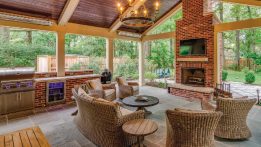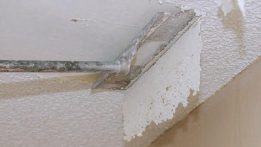 Landscaping is a beautiful way to accentuate your home, but if you aren’t familiar with planting and fertilization, it can seem like a difficult task to begin. The question on many homeowners’ minds is this: where do I start? There are many aspects to consider when starting your landscaping adventure. Thankfully, professional landscapers are available to guide you in the right direction.
Landscaping is a beautiful way to accentuate your home, but if you aren’t familiar with planting and fertilization, it can seem like a difficult task to begin. The question on many homeowners’ minds is this: where do I start? There are many aspects to consider when starting your landscaping adventure. Thankfully, professional landscapers are available to guide you in the right direction.
What to Discuss with Your Landscaper
Whether you’re calling because your landscape has been monotonously unchanged for twenty years or your yard is starting to resemble a jungle, landscapers need to know what they’re working with. In most cases, landscapers can’t begin drafting a design for your yard until they at least see a picture of your current yard. It’s also helpful to provide some information about your current landscape. For example, drainage can make it or break it in the landscaping world, so educating yourself of your yard’s drainage system before contacting a professional is extremely helpful. Improper drainage can be the downfall of your yard whether it’s faulty gutters or water traps that create excesses of water around your plants. Once this information is considered, professionals can then devise a plan for planting and fertilization. Some plants thrive in an abundance of water, but others rot and die quickly after being too exposed. Additionally, landscapers will choose plants that work well with the soil in your yard. In North Florida, soil can be tricky; there are many types of soils that are temperamental during seasonal changes, so discussing this with a landscaper is highly encouraged. Location is another important consideration. Is the area you want to redesign in the sun or shade? Is it on a hill? Is it in the middle of the yard or by your house? The answers to these questions will assist the landscaper while drafting. Knowing the size of the area and whether or not it receives a plethora of sunlight is key for any professional. Once the drainage system, soil type, and location are examined, a landscaper can now envision your future yard with the right flowers and plants. Finally, the budget can be determined. Landscaping can range from $300 to thousands of dollars depending on your financial investment. No matter the cost, a landscaper will help you plan for a beautiful, aesthetically-pleasing landscape in no time.
Design
Starting with a focal point is a good idea when thinking of design. You might have a large oak tree or an ornamental fountain you want to accentuate. The idea is to make the focal point stand out and connect effortlessly with the rest of your landscape. Blending your surroundings into a singular, whimsical design is what landscapers do best. Your landscape can showcase an overarching style with proper placement and embellishments. Plants look best when layered appropriately; a plant that’s eight feet tall can rapidly overshadow a smaller plant if not placed correctly. Adding a garden is also another way to make your landscape come full circle. Not only can you save money by growing your own fruits and vegetables, but there’s a sense of pride when reaching for home-grown tomatoes or basil when cooking. Although gardening for beginners is a trial-and-error process, there’s nothing better than seeing lively, green plants after weeks of hard work. Flower beds are similar to gardens because you must invest time for them to flourish, but they offer more aesthetic to your home with bright hues and sweet scents. Plus, birds and butterflies will be attracted to the flowers and will most likely visit your yard often.
After completing the design, supplementing your landscape with pavers is another way to highlight your artistic taste. Pavers are a simple solution when looking to tie your home and landscape together, especially if you want to improve your overall curb appeal and raise your property value. Plus, the average lifespan of concrete pavers is 25-35 years, so you won’t have to worry about longevity and durability with pavers. There is a variety of colors and styles to choose from, including stone, brick, and concrete, and your landscaper can help you decide the best option for you.
Maintenance
 Maintenance of your yard is relatively self-explanatory; if you think the plants look too dry, water them, and if you think they’ve grown too tall, cut them. The secret to landscape upkeep is trusting your instincts and knowing the signs of a yard that needs a little love. It’s important to also keep in mind that as the seasons change, your landscape will change too. For example, when winter comes, it would be a good idea to wrap that large oak tree in a tree guard or check the irrigation system for any cracks the weather might have caused. During summer, it’s crucial to mow the grass regularly and water the lawn two times a week. Doing some research on your plants is beneficial so you can receive an in-depth understanding of your new-and-improved landscape. If you have any questions or concerns, contact your landscaper. Professionals are here to offer advice and to give you a rundown of what to expect of your landscape.
Maintenance of your yard is relatively self-explanatory; if you think the plants look too dry, water them, and if you think they’ve grown too tall, cut them. The secret to landscape upkeep is trusting your instincts and knowing the signs of a yard that needs a little love. It’s important to also keep in mind that as the seasons change, your landscape will change too. For example, when winter comes, it would be a good idea to wrap that large oak tree in a tree guard or check the irrigation system for any cracks the weather might have caused. During summer, it’s crucial to mow the grass regularly and water the lawn two times a week. Doing some research on your plants is beneficial so you can receive an in-depth understanding of your new-and-improved landscape. If you have any questions or concerns, contact your landscaper. Professionals are here to offer advice and to give you a rundown of what to expect of your landscape.
Landscaping can be tricky if you’re inexperienced with planting and fertilization. The best option would be to call a professional landscaper to gain knowledge about this new addition to your home. Before embarking on this landscaping adventure, make sure to do some research beforehand so that you can discuss your preferences and budget with a professional. Once this project is complete, not only will you feel satisfied with the aesthetics of your yard, but also your curb appeal and property value will greatly improve, drawing the attention of envious neighbors and potential home buyers. After your landscape is finished, the grass really will be greener on your side. ![]()
Home & Yard Magazine
Demi Morelock




